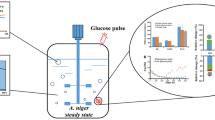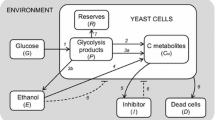Abstract
Mass balances analysis of polyphasic dispersed systems showed that cellular cycling of the substrate involves (a) an increase in the specific metabolisation rate and (b) a decrease in the biomass yield coefficient (energy spilling). In biomass calculations, the substrate release rate can replace the maintenance coefficient concept. Thus, decreasing the substrate transfer rates could improve cells or microorganisms strains of industrial importance.
Similar content being viewed by others
References
Bond DR, Russell JB (1998) Relationship between intracellular phosphate, proton motive force, and rate of nongrowth energy dissipation (energy spilling) in Streptococcus bovis JB1. Appl. Environ. Microbiol. 64: 976–981.
de Hollander JA (1993) Kinetics of microbial products formation and its consequences for the optimization of fermentation processes. Antonie van Leeuwenhoek 63: 375–381.
Glazer N, Nikaido H (1995) Microbial Biotechnology-Fundamentals of Applied Microbiology. New York: W.H. Freeman & Co.
Kuenen JG (1979) Growth yields and 'maintenance energy requirement' in Thiobacillus species under energy limitation. Arch. Microbiol. 122: 183–188.
Kwong SCW, Rao G (1994) Metabolic monitoring by using the rate of change of NAD(P)H fluorescence. Biotechnol. Bioeng. 44: 453–459.
Marr AG (1991) Growth rate of Escherischia coli. Microbiol. Rev. 55: 316–333.
Nielsen J, Villadsen J (1994) Bioreaction Engineering Principles. New York: Plenum Press.
Pirt SJ (1982) Maintenance energy: a general model for energylimited and energy-sufficient growth. Arch. Microbiol. 133: 300–302.
Robertson BR, Button DK (1979) Phosphate-limited continuous culture of Rhodotorula rubra: kinetic of transport, leakage and growth. J. Bacteriol. 138: 884–895.
Tempest DW, Neijssel OM (1984) The status of YAT P and maintenance energy as biologically interpretable phenomena. Ann. Rev. Microbiol. 38: 459–486.
Thierie J (1997) Why does bacterial composition change with the chemostat dilution rate? Biotechnol. Tech. 11: 625–629.
Tsai SP, Lee YH (1990) A model for energy-sufficient growth. Biotechnol. Bioeng. 35: 138–145.
Walker GM (1998) Yeast-Physiology and Biotechnology. London: John Wiley & Sons Ltd.
Westerhoff HV, Lolkema JS, Roel O, Hellingwerf KJ (1982) Thermodynamics of growth-non equilibrium thermodynamics of bacterial growth. The phenomenological and the mosaic approach. Biochim. Biophys. Acta 683: 181–220.
Author information
Authors and Affiliations
Rights and permissions
About this article
Cite this article
Thierie, J. Cellular cycling of substrate as a possible cryptic way for energy spilling in suspended cellular continuous cultures. Biotechnology Letters 22, 1143–1149 (2000). https://doi.org/10.1023/A:1005616520482
Issue Date:
DOI: https://doi.org/10.1023/A:1005616520482




